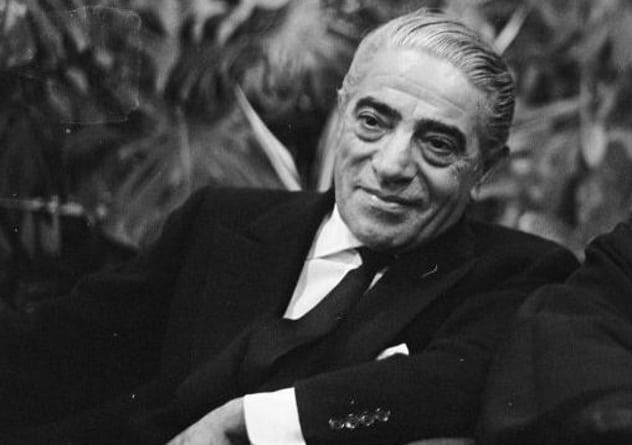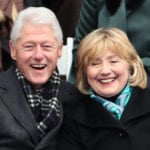 Animals
Animals  Animals
Animals  Facts
Facts Ten Unexpectedly Fascinating Facts About Rain
 Crime
Crime 10 Dark Details of Australia’s Gruesome Unsolved Wanda Murders
 Humans
Humans 10 Unsung Figures Behind Some of History’s Most Famous Journeys
 Animals
Animals 10 Species That Refused to Go Extinct
 Weird Stuff
Weird Stuff 10 Weird Things People Used to Do at New Year’s
 Our World
Our World 10 Archaeological Discoveries of 2025 That Refined History
 Weird Stuff
Weird Stuff 10 Fascinating Facts You Might Not Know About Snow
 Miscellaneous
Miscellaneous Top 10 Things Crypto Was Supposed to Change & What Actually Did
 History
History 10 Huge Historical Events That Happened on Christmas Eve
 Animals
Animals 10 Strange Times When Species Evolved Backward
 Facts
Facts Ten Unexpectedly Fascinating Facts About Rain
 Crime
Crime 10 Dark Details of Australia’s Gruesome Unsolved Wanda Murders
Who's Behind Listverse?

Jamie Frater
Head Editor
Jamie founded Listverse due to an insatiable desire to share fascinating, obscure, and bizarre facts. He has been a guest speaker on numerous national radio and television stations and is a five time published author.
More About Us Humans
Humans 10 Unsung Figures Behind Some of History’s Most Famous Journeys
 Animals
Animals 10 Species That Refused to Go Extinct
 Weird Stuff
Weird Stuff 10 Weird Things People Used to Do at New Year’s
 Our World
Our World 10 Archaeological Discoveries of 2025 That Refined History
 Weird Stuff
Weird Stuff 10 Fascinating Facts You Might Not Know About Snow
 Miscellaneous
Miscellaneous Top 10 Things Crypto Was Supposed to Change & What Actually Did
 History
History 10 Huge Historical Events That Happened on Christmas Eve
10 Fascinating Conspiracy Claims Of The Gemstone File
What makes the so-called Gemstone File so intriguing is that while no one can prove its authenticity, plenty of the claims within its pages have proven to be very true. Essentially, the Gemstone File is said to be the notes and results of an extensive investigation by “Bruce Roberts” into such people as Howard Hughes, the Kennedys, and ultimately Aristotle Onassis. They paint a grim picture of who really controlled events during the latter half of the 20th century in the United States.
This is assuming you believe the Gemstone File is true, though. In fact, the debate over the authenticity of the conspiracy theorists’ dream that is the Gemstone File is where we will start our list, as it also explains in a little more detail just what the file actually is.
10 It Is The Modern-Day Version Of The Tulli Papyrus

Although its influence, at least in conspiracy circles, is undeniable,[1] the fact is that nobody other than Bruce Roberts and conspiracy theorist Mae Brussell (who are both dead) are alleged to have actually seen the original “file.” Copies were distributed via the post to targeted researchers or, in some instances, passed over by hand.
Eventually, author Stephanie Caruna was given permission to use the file to write the book A Skeleton Key to the Gemstone File, which would tell of the “planned events” of the second half of the 20th century following the end of World War II. While some of the claims border on outrageous, others, if only partially, have proven to be eerily accurate.
Perhaps most interesting were the claims surrounding the murder of President John F. Kennedy and fallout thereof, which we will look at a little later. For the next entry on our list, however, we will look at the alleged reason for the naming of the Gemstone File.
9 The Author Claimed To Be The Real Inventor Of The Laser Beam

According to Roberts, he became involved within the twisting world of conspiracies when he approached Howard Hughes’s organization in the late 1960s with his invention, a synthetic ruby that is required for laser technology.[2] He was looking for financial backing. However, he would claim that he was swindled out of both his invention and the patent for it. He refused to let it go, however, and began investigating the organization as part of his determined effort to prove that the “gemstones” in laser technology were his invention—hence, the Gemstone File.
What he found out, though, was far more than he ever intended or imagined. In an account that many conspiracy researchers have echoed since, Roberts would state, through the Gemstone File, that a select “elite” few ruled the United States, and their influence stretched out worldwide. In fact, the person who was really running the show, according to the Gemstone File, is one of the most well-known names of the mid-20th century.
8 Aristotle Onassis Ruled The US

There is no doubt that Aristotle Onassis was a powerful man. According to the Gemstone File, however, Onassis was more than just powerful—he was running the whole show.[3] As we will look at as we continue down our list, if we are to believe the authenticity and accuracy of the file, then Onassis, through several bold and crucial deals made in the 1930s (after a lifetime of jockeying for position with his contemporaries), would put him in a unique position.
He had connections going in all directions, including specifically close ones to the Perons and Winston Churchill. Onassis was also close to the Bouvier family, who have close connections to Masonic lodges and the (so-called) Illuminati and whose daughter, Jackie, would go on to marry the eventual US president, John Kennedy.
By the time of the 1960 US presidential election, Aristotle Onassis was in a situation in which he simply couldn’t lose. We will look at that election a little closer later on, but first, we will turn our attention to the winner of it, John Fitzgerald Kennedy, who the Gemstone File states was ultimately murdered on the orders of Aristotle Onassis.
7 The JFK Murder Revelations

Okay, regardless of who did assassinate JFK, even the most skeptical person would surely have to admit the official story is not entirely accurate. It might be worth bearing in mind, however, that in 1975, when the claims in the Gemstone File were made, the conspiracy theories surrounding JFK were ample enough but not as widespread or at the levels of scrutiny they would soon reach.
Although there appear to be several reasons that built up over his short presidency, it would seem that John, and later his brother Robert, whether in an effort to do the right thing or to seize power for themselves, began to distance themselves from Onassis following the death of their influential father. Interventions on planned assassinations of Castro, as well as Kennedy’s desire to avoid war in Vietnam, appear to have been the final straw for Onassis’s patience.[4]
According to the Gemstone File, there was a planned assassination attempt on November 1, 1963, in Chicago at a football game that Kennedy was due to appear at. However, following the leaking of information to the president, he canceled the appearance at the last minute. Of course, three weeks later, he was not so lucky. Most of us are familiar with the circumstances under which Kennedy died in Dallas on November 22, 1963. In our next entry, we will look instead at some of the apparent revelations contained within the Gemstone File regarding the most famous assassination in living memory.
Incidentally, following Kennedy’s death, Jackie would eventually marry Aristotle Onassis. It is said in Greek culture (from which Onassis descends) that if you murder a man, then you must then take care of his children and marry his wife. Given all the apparent “secret society” types of activities going on in the background, make of all of that what you will.
6 Aftermath And Oswald Revelations

According to the file, there were a total of four shooters, including Lee Harvey Oswald.[5] The remaining three were Mafia men who positioned themselves across from the book depository, opposite the grassy knoll, and behind the fence at the grassy knoll. Each man also had a backup who would dispose of the shells and the weapon, allowing the shooters to escape via the sewer systems (as the grassy knoll shooters did) or blend into the crowd as a police officer and a concerned citizen (as the remaining shooters did).
Furthermore, the backups, and the “timers,” who would give the shooters the signal to fire, were largely dressed as tramps and locals. After disposing of the weapons, they would remain where they were and wait to be picked up, questioned, and released with no report made by police.
Oswald, according to the file, was ordered to fire at Governor Connolly. He did this and then, as instructed, left the gun to be picked up by his backup. However, unbeknownst to him, no one was coming to remove his gun. It would be left there for the police to find—which they did, and within hours they would have both the suspect and the weapon, complete with fingerprints and witnesses placing him at the scene. From an appreciation of planning and execution, it was almost perfection.
Furthermore, the “undercover work” that Oswald had undertaken for the CIA merely provided his own motive as a communist-leaning radical to want to commit such an act. To say he was set up would be an understatement.
Oswald’s murder, however, was a last-minute arrangement. Following the gunning down of the police officer J.D. Tippet, who the file states was not killed by Oswald but two of Onassis’s men, it was thought that Dallas police would shoot Oswald on sight. However, when they arrested him unharmed, it presented an urgent problem for those behind the plot. A meeting was arranged with local Mafia man Jack Ruby (which the Warren Commission notes as having taken place). It is thought at this meeting at the Cabana Motel, Ruby was given orders to “deal with” the Oswald problem. Using insiders, the police received orders to take Oswald out of the Dallas police station the following day through an unsecured walkway, allowing Ruby to shoot him at point-blank range.
5 The Howard Hughes Conspiracy

Of course, in the mid-1950s, before the above events played out or were even planned, the equally influential Howard Hughes was proving to be an increasingly large thorn in Onassis’s side.[6] Hughes was said to be to Vice President Richard Nixon what Onassis was John Kennedy. Rumor states that Hughes made a “non-repayable loan” of $250,000 to Nixon’s brother in 1956. The following year, apparently unrelated, Hughes’ organization, the Hughes Medical Foundation, was awarded tax-free status.
Realizing that Nixon may prove to be a problem in the eventual 1960 election (he did run against Kennedy), Onassis looked to deal with the source of his influence rather than Nixon himself. And so, in March 1957, according to the Gemstone File, Hughes was kidnapped from his California home and smuggled out to an entirely booked-out floor of the Emerald Isles Hotel in the Bahamas.
According to the file, he was eventually moved to Onassis’s privately owned island of Skorpios, where he would remain imprisoned. One of his sometimes body doubles, L. Wayne Rector, would assume Hughes’s identity as part of Onassis’s growing payroll. Interestingly or not, it was around this time that Hughes’s public appearances began to become minimal. Apparently, Hughes was kept alive, although heavily drugged and sedated, for the purpose of obtaining his signature on occasion for documents. Again, these are outlandish claims, but they’re woven around circumstances (the bribery, etc.) that are all but proven.
4 1932 Prohibition Deal

According to Roberts’s file, “the conspiracy” went back to at least 1932, as the United States was nearing the end of Prohibition.[7] During this time, Onassis entered into a deal with Joseph Kennedy, Eugene Meyer, and Meyer Lansky to smuggle alcohol into the United States. Kennedy would use his well-known “Mafia connections” to distribute the booze around the county. Even following the repeal of Prohibition, the connections were so well-established that illegal liquor continued to be a money-earner for those willing and able to indulge in such a service. Those connections would also morph into ones that dealt in drugs such as cocaine and heroin decades later.
This “pulling together” of common interests of such individuals organized by Onassis—if you believe the authenticity of the file, of course—would finance the group, who would look to take full advantage of their sudden nationwide influence. And following the end of World War II, they would swoop in to exploit the sudden availability of certain hardware (hardware they had already made millions of dollars from during the war). In fact, that is something we will look at in our next entry.
3 Oil And Media Takeover

The next key move in the march to taking over the US was the 1934 takeover of the oil business (or at least an acquisition of a sizeable amount of control). According to the file, Onassis entered into an arrangement with the Rockefellers and the Seven Sisters (seven big oil companies) to “f—k the Arabs out of their oil.” Onassis already owned several transport ships. And, whether he knew it at the time or not, in a decade, he would own more.
As we mentioned, following the end of World War II, Onassis would be involved in some questionable deals with the United States military. In particular, he purchased surplus warships for the purpose of transporting all of the extra oil they were ready to move from the Middle East. There were pockets of resistance to the purchase, but the proposal went ahead, and the ships belonged to Onassis to do with as he pleased.
Two years after the oil deal, in 1936, the first moves of controlling the American media went into action. At Onassis’s encouragement, Eugene Meyer purchased controlling rights to The Washington Post. At the same time, several Mafia families would begin purchasing smaller publications and platforms.[8]
2 1960 US Presidential Election

Following his “buying” of Nixon (which Onassis treated as taking on a man’s debts after having Hughes removed) and his already deep control of Kennedy, as the 1960 US presidential election approached, whichever way the public voted, Onassis would have an open door to the White House—at least according to the plan.[9] As we have examined above, Onassis didn’t account for the Kennedys turning on him, if indeed that is what happened.
It wasn’t just Onassis, either. His longtime associates and corporate families, as well as many Mafia figures who were well-known and influential in their own right, were also positioned to reap the rewards of making sure one of “their” guys would soon to be calling the shots. Given that Onassis would also control Kennedy’s successor Lyndon Johnson in the same way, and Nixon would also eventually see time in the White House, perhaps the conspiracy of Aristotle Onassis being one of the most powerful men in the United States is not understated or to be dismissed. It should perhaps also be noted that several researchers have connected the Onassis family to the Freemasons and Illuminati. It is said that Aristotle Onassis was one of the highest-ranking members of such organizations.
1 The Two Murders Before JFK

According to the Gemstone File, before the assassination of John F. Kennedy could proceed, there were two important murders that had to take place first.[10] Apparently, two people were close to exposing the conspiracy in the fall of 1962 and into 1963.
The first was Senator Estes Kefauver, who died two days after a heart attack on the Senate floor. According to the version of history offered by Roberts’s file, this was a heart attack brought on by a poisoned piece of apple pie the senator was eating immediately before taking the floor. Apparently, he was about to speak publicly of the backhanded nature of Onassis’s business dealings and how far into US politics his reach actually was.
The second was Phil Graham, the son-in-law of the owner of The Washington Post. A huge Kennedy supporter to begin with, he began to suspect untoward happenings and looked to expose the conspiracy. Graham’s wife, Katherine Meyer Graham, had her husband committed to a mental asylum temporarily. Shortly after returning home, his dead body was discovered with a bullet wound to the head. His death was, of course, ruled a suicide.
Read about more conspiracy theories pertaining to historical events on Top 10 Enduring Conspiracy Theories About Tragic Events and 10 Bizarre Conspiracy Theories Of The First Gulf War.








